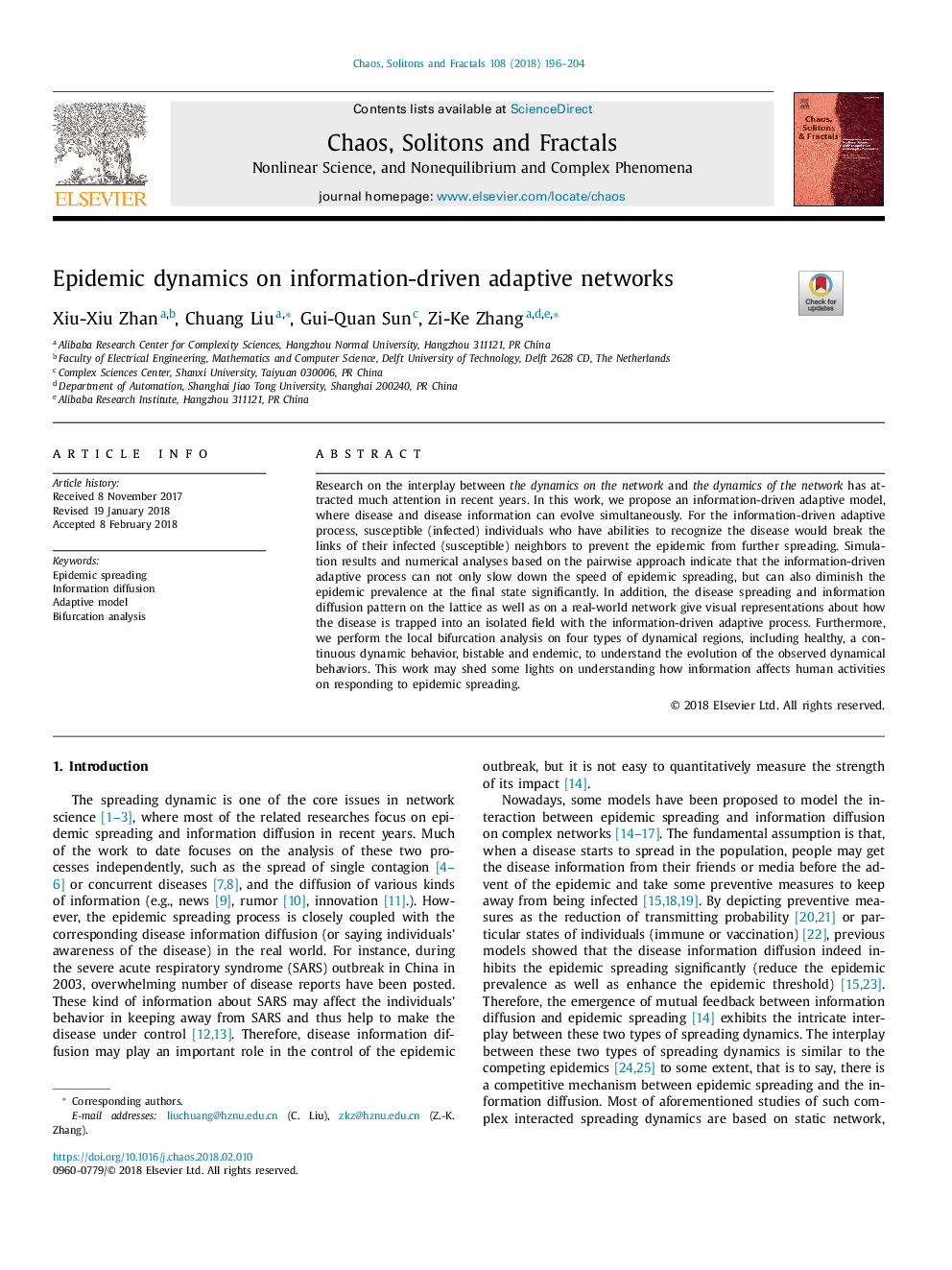| کد مقاله | کد نشریه | سال انتشار | مقاله انگلیسی | نسخه تمام متن |
|---|---|---|---|---|
| 8254037 | 1533617 | 2018 | 9 صفحه PDF | دانلود رایگان |
عنوان انگلیسی مقاله ISI
Epidemic dynamics on information-driven adaptive networks
ترجمه فارسی عنوان
دینامیک اپیدمی در شبکه های انطباق یافته مبتنی بر اطلاعات
دانلود مقاله + سفارش ترجمه
دانلود مقاله ISI انگلیسی
رایگان برای ایرانیان
کلمات کلیدی
گسترش اپیدمی، انتشار اطلاعات، مدل سازگار، تجزیه دوبختی،
ترجمه چکیده
تحقیقات در مورد تاثیرات بین پویایی در شبکه و پویایی شبکه، در سال های اخیر توجه زیادی را به خود جلب کرده است. در این کار، ما یک مدل سازگاری مبتنی بر اطلاعات ارائه می دهیم، در حالیکه اطلاعات بیماری ها و بیماری ها می توانند به طور همزمان تکامل پیدا کنند. برای فرآیند انطباق مبتنی بر اطلاعات، افراد حساس (آلوده) که توانایی تشخیص بیماری دارند، لینک های همسایگان آلوده (حساس) را از بین می برند تا از گسترش همه گیر شدن آن جلوگیری شود. نتایج شبیه سازی و تجزیه و تحلیل عددی بر مبنای رویکرد دوگانه نشان می دهد که فرایند تطبیقی مبتنی بر اطلاعات می تواند نه تنها سرعت سرعت گسترش همه گیر شدن را کاهش دهد، بلکه می تواند موجب کاهش شیوع اپیدمی در حالت نهایی شود. علاوه بر این، گسترش بیماری و الگوی پخش اطلاعات بر روی شبکه و همچنین در یک شبکه دنیای واقعی، نمایانگر بصری در مورد چگونگی تداوم بیماری با یک فرآیند انطباق با اطلاعات است. علاوه بر این، ما تجزیه و تحلیل بیوگرافی محلی را بر روی چهار نوع از مناطق دینامیکی انجام می دهیم، از جمله سالم، یک رفتار پویا مداوم، دوام و یکپارچه، برای درک تکامل رفتار های دینامیکی مشاهده شده. این کار ممکن است برخی از فاکتورها را در درک اینکه چگونه اطلاعات بر روی فعالیت های انسانی در پاسخ به گسترش بیماری همه گیر تاثیر می گذارد، رها می کند.
موضوعات مرتبط
مهندسی و علوم پایه
فیزیک و نجوم
فیزیک آماری و غیرخطی
چکیده انگلیسی
Research on the interplay between the dynamics on the network and the dynamics of the network has attracted much attention in recent years. In this work, we propose an information-driven adaptive model, where disease and disease information can evolve simultaneously. For the information-driven adaptive process, susceptible (infected) individuals who have abilities to recognize the disease would break the links of their infected (susceptible) neighbors to prevent the epidemic from further spreading. Simulation results and numerical analyses based on the pairwise approach indicate that the information-driven adaptive process can not only slow down the speed of epidemic spreading, but can also diminish the epidemic prevalence at the final state significantly. In addition, the disease spreading and information diffusion pattern on the lattice as well as on a real-world network give visual representations about how the disease is trapped into an isolated field with the information-driven adaptive process. Furthermore, we perform the local bifurcation analysis on four types of dynamical regions, including healthy, a continuous dynamic behavior, bistable and endemic, to understand the evolution of the observed dynamical behaviors. This work may shed some lights on understanding how information affects human activities on responding to epidemic spreading.
ناشر
Database: Elsevier - ScienceDirect (ساینس دایرکت)
Journal: Chaos, Solitons & Fractals - Volume 108, March 2018, Pages 196-204
Journal: Chaos, Solitons & Fractals - Volume 108, March 2018, Pages 196-204
نویسندگان
Xiu-Xiu Zhan, Chuang Liu, Gui-Quan Sun, Zi-Ke Zhang,
